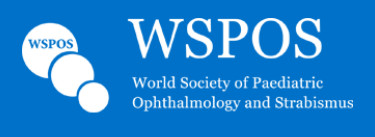Education
Case Report: Case 7
Case Presenters
Dr. Susana Gamio, M.D. is Currently a Professor of Pediatric Ophthalmology and Strabismus at the Maimónides University, the Buenos Aires National University (UBA) and at the UCA University. She is also the Chief of the Ophthalmology Unit in the Ricardo Gutierrez Children´s Hospital, Buenos Aires, Argentina since 2006 in addition to being the Chief of the Project On Elimination of Avoidable Childhood Blindness in Argentina by the Lions Club International Foundation (LCIF) and WHO (World Health Organization) since 2003.
Dr. Gamio was the President of the Argentinian Strabismological Center (CAE) from 2006 – 2009 & was the President of the Argentinian Pediatric Ophthalmology Society (SAOI) from 2010 – 2013. Dr. Gamio acquired her M.D. from the Córdoba National University (UNC), Córdoba, Argentina in 1978, following which she underwent an Ophthalmology training in 1985 from the Buenos Aires National University (UBA), Buenos Aires, Argentina. She then went on to procure her Magister degree in Strabismus and Motility Disorders in 2000 from the Universidad del Salvador, Buenos Aires, Argentina.
Status: CASE CLOSED
Members’ Responses:
When our members were asked (1) How do you explain this pattern?
0% responded saying ‘III nerve paresis’
17.65% said ‘IO palsy’
82.35% replied saying ‘A pattern XT with asymmetric SOOA’
(2) Which procedure do you prefer for weakening SOOA?
76.47% preferred ‘SO tenectomy’
11.76% opted for ‘SO tendon elongation’
The remaining 11.76% answered ‘SO tendon recession’.
(3) How do you explain the Head Tilt Test difference?
11.76% replied saying ‘IO palsy’
23.53% of our members’ reply was ‘SR overaction / contracture syndrome’
64.71% answered saying ‘XT with asymmetric SOOA’.
Experts Opinion
In addition to answering the questions posed to our members, our Experts were also asked the following questions: 1) Assuming the medial rectus was adherent to the orbital defect, would you expect a positive forced duction test? 2) What would be the optimal time for surgery? 3) If the muscle had been transected and a large segment were missing or destroyed, what would be your surgical approach?
Massimiliano Serafino

Dr Massimiliano Serafino, also known as Max, is the Head of Ophthalmology Unit at Giannina Gaslini Institute – Children’s Hospital in Genoa, Italy. He teaches Strabismus at Ophthalmology Residency at University of Milan.
Dr Serafino completed his Ophthalmology residency at San Paolo Hospital in Milan, Italy. He completed his fellowship in Pediatric Ophthalmology and Adult Strabismus in 2002 at Storm Eye Institute in Charleston, South Carolina, USA and his observership in Genetics and Pediatric Glaucoma in 2012 at Wills Eye Hospital in Philadelphia, USA.
He was European Board Ophthalmology examinator in May 2019.
Dr Serafino has authored publications in various peer-reviewed journals and published many book chapters in the field of pediatric ophthalmology and strabismus. He also has many abstracts, reviews and invited lectures at various international and national meetings. He currently serves as a reviewer for multiple journals.
Now, he lives in Genoa with his wife Monica and his two lovely dogs.
1) How do you explain this pattern?
III nerve paresis; In my opinion she has a paresis of IO and MR in RE. This could explain her pattern:
– XT in primary position
– more XT in left gaze (15PD)
– left head turn
– stereopsis in right gaze (6PD)
– A pattern (relative SO overaction)
The intorsion in the left eye could be explained with a SR contracture. In primary SO overaction there is no head tilt
(2) Which procedure do you prefer for weakening SOOA?
SO tenectomy; In this case I am not scared about postoperative IO overaction because IO is paretic. So my favourite approach would be the SO tenectomy.
(3) How do you explain the Head Tilt Test difference?
IO palsy; Patient with IO palsy has an objective intorsion (as shown in this case). This means patient could have a head tilt on the same side of the affected eye (in our case could be right head tilt). If you perform an HTT on the opposite side (left tilt) the right eye will have a slight extorsion. The 2 muscles that can extort the eye are IO and IR; the IO is paretic than the IR will contract and the eye will go down. This explains why our patient has a left HT (20PD) during HTT (Left tilt)
(4) Do you think that IO palsy is a benign entity?
IO palsy is rare and idiopathic. The exact cause is unknown and has not been associated with any neurological abnormalities.
(5) What is your approach to treat a patient with IO palsy?
I would treat only patient with diplopia, moderate to severe abnormal head posture and vertical deviation in primary position. My approach is superior oblique weakening procedure alone or associated with controlateral superior rectus muscle recession if vertical deviation is more than 10PD.
Federico Velez

Dr. Federico G. Velez is an Associate Professor, Division of Pediatric Ophthalmology and Strabismus, Department of Ophthalmology, Duke Eye Center, Duke University, Durham, North Carolina in addition to being an Associate Physician Diplomate, Pediatric Ophthalmology and Strabismus at the Doheny Eye Institute, University of California Los Angeles, Fountain Valley, California. He is the Vice-Chair of the American Association for Pediatric Ophthalmology and Strabismus Adult Strabismus Taskforce, a Member of the American Association for Pediatric Ophthalmology and Strabismus Education Committee, Chairs the International Colombian Ophthalmologists, and is on the American Academy of Ophthalmology Knowledge Base Pediatric Ophthalmology / Strabismus – Member Subcommittee. He is also a member of the Association for Research in Strabismus (Squint Club) , American Association for Pediatric Ophthalmology and Strabismus (AAPOS), World society of Pediatric Ophthalmology and Strabismus (WSPOS), American Academy of Ophthalmology (AAO), Latin-American Council of Strabismus (CLADE), Latin-American Society of Pediatric Ophthalmology (SOPLA), Colombian Society of Pediatric Ophthalmology and Strabismus (ACOPE), Colombian Society of Ophthalmology, European Strabismological Association (ESA), International Strabismological Association (ISA), California Medical Association. He is on the Editorial Board, Journal of The American Association of Pediatric Ophthalmology and Strabismus (J AAPOS), Editorial Board, Journal of the Colombian Society of Ophthalmology, Editorial Board, BioMed Research International (Journal of Biomedicine and Biotechnology), Editorial Board Advisory Panel, Treatment Strategies – Pediatrics, The Cambridge Research Centre in addition to being a reviewer for the British Journal of Ophthalmology, the JAMA Ophthalmology. He has given 360 lectures and presentations, 23 guest / named lectures, has 88 research papers (peer reviewed) in addition to 4 research papers – peer reviewed (submitted), 8 research papers (non-peer reviewed), authored 10 book chapters, has 3 book chapters in press & also has authored 5 letters to the editor. He has 9 papers in preparation (research completed), in addition to 114 abstracts.
He has taught / is currently teaching 19 courses at UCLA in addition to performing Community Service at the Care Harbor, LA, Special Olympics World Games. He has also received the Journal of AAPOS Outstanding Reviewer award in addition to the Teaching Award, Jules Stein Eye Institute, UCLA School of Medicine & the AAPOS Honor Award. Dr. Velez’s primary focus of research includes understanding the pathogenesis and new approaches to pediatric and adult strabismus and pediatric lens surgery. As a principal investigator he has received grant support from the National Eye
Institute, Knights Templar Eye Foundation, Gerald Oppenheimer Family Foundation Center for the Prevention of Eye Disease to develop an electrical-stimulation device to prevent strabismic amblyopia and correct strabismus and strabismus in patients with acquired immune deficiency syndrome, and from Bausch & Lomb, Omerons and Retrophin for research in pediatric cataracts.
(1) How do you explain this pattern?
There are several diagnostic possibilities. Patient has right under elevation all gazes worse in adduction, right over depression more in adduction and the left eye shows limited downgaze in all gazes worse in abduction. Right inferior oblique weakness, right superior oblique overreaction, left superior rectus overaction, left inferior rectus muscle weakness can all create very similar patterns with similar torsion. If I value, the Bielschowsky (which in chronic deviations can mislead the diagnosis) then it is unlikely that this patient has a left inferior rectus muscle paresis leaving me with 3 possible diagnoses. The horizontal pattern in my opinion does not help with the final diagnosis. Interestingly the surgeon indicates that the forced duction test was negative. If correct then the most likely diagnosis is a right inferior oblique paresis. However, this won’t explain the left hypertropia in right gaze. I would have expected no left hypertropia in right gaze. One limitation of the forced duction test is an overacting not tight muscle. So a superior oblique overaction and superior rectus overaction can again explain the pattern here presented without necessarily having a positive forced duction test which I will see in patients with muscle contracture not necessarily an overacting muscle. The diagnosis of inferior oblique palsy is doubted by some strabismologists. If the problem is the innervational I see two possible locations, 3rd nerve nucleus where there is a specific representation for the inferior oblique, or in the orbit after the inferior branch of the 3rd nerve left branched to the inferior oblique. A muscle hyopoplasia as has been published (Ela Dalman et all J AAPOS) can explain the finding of under elevation in adduction, intorsion, a pattern. But still in my opinion wont explain the left hypertropia in right gaze. Except if there is a secondary overaction of the left superior rectus muscle either primary or secondary causing limitation to downgaze rotation of the left eye worse in abduction, a pattern, underaction of the ipsilateral antagonist inferior rectus muscle with over action of the contralateral antagonist muscle superior oblique.
(2) Which procedure do you prefer for weakening the SOOA?
My decision is based on the amount of deviation in primary position, the forced duction test and whether I am operating or not on another vertical muscle. Deviations of less than 5 PD, I perform posterior tenectomy. If the forced duction test is positive and the deviation ranges between 5-10 PD, I rather do a lengthening procedure either z lengthening or spacer; if the deviation is larger than 5 PD with negative forced duction test and patients with more than 10 PD of deviation in primary position, I add a second vertical muscle to for example a posterior tenectomy.
(3) How do you explain the Head tilt test difference?
For this patient all 3 options are possible and a final diagnosis is not possible based on the Bielschowsky manoeuvre. In my opinion (not necessary because the surgical treatment was appropriate) the only test I would have considered was a high resolution MRI of the orbit.
(4) Do you think the IO palsy is a benign condition?
It will be exceptional for a malignant orbital lesion or brain lesion including a malignant lesion or an aneurysm to present as an isolated inferior oblique muscle palsy. There could be 3rd nerve neuromas that could potentially affect the branch to the inferior oblique or a brain stem vascular lesion or inflammatory condition affecting the nucleus to the inferior oblique but I believe more inferior oblique palsies are related to congenital abnormalities that decompensate overtime just like most non-traumatic (normal brain imaging) superior oblique paresis.
(5) What is your approach to treat a patient with IO palsy pattern?)
I consider imaging as I usually recommend for all patients who present with a new onset cyclovertical deviation. Surgery depends on the deviation but usually involves ipsilateral superior oblique muscle weakening plus a contralateral superior recuts muscle weakening procedure. In some cases, I consider strengthening the contralateral inferior rectus muscle.
Fay Cruz
Dr. Fay Charmaine Cruz is the current president of the Philippine Society of Pediatric Ophthalmology and Strabismus (PSPOS). She obtained her medical degree at University of Santo Tomas, Manila. Her residency was at The Medical City in Pasig City and completed her training with fellowships at the University of California, San Diego in Pediatric Ophthalmology and Strabismus. Dr. Cruz has ten years of experience in ophthalmic surgery, with special interest in congenital cataract surgery, strabismus surgery, and retinopathy of prematurity. She is also a practicing physician at the Department of Health Eye Center and actively involved in fellowship training. In addition to her surgical practice, she is also an Associate Professor at the University of the East – College of Medicine and currently completing her Master’s Degree in Health Science Education.
Dr. Cruz is also a councilor of the Philippine Academy of Ophthalmology and a member of the World Society of Pediatric Ophthalmology and Strabismus (WSPOS) and Asia-Pacific Strabismus and Pediatric Ophthalmology Society (ASPOS).
(1) How do you explain this pattern?
IO palsy; the patient presented with a limited adduction on elevation of the right eye, no restriction was noted on forced duction, an overacting superior oblique and fulfills the three step test for an inferior oblique palsy on the right eye
(2) Which procedure do you prefer for weakening the SOOA?
SO tenectomy; SO tenectomy on the right eye and an SR recession on the contralateral eye will address the hypertropia as well as the A- pattern
(3) How do you explain the Head tilt test difference?
IO palsy
(4) Do you think the IO palsy is a benign condition?
As stated in the clinical strabismus management book by Rosenbaum and Santiago, IO palsy is usually idiopathic and benign in nature. The MRI results of the patient was also negative.
(5) What is your approach to treat a patient with IO palsy pattern?
The management of the case is dependent on the spread of comitance and the severity of the oblique dysfunction. In the case presented, I will follow the same procedure.
Elias Traboulsi
Dr. Elias I. Traboulsi is the Head of the Department of Pediatric Ophthalmology and the Director of the Center for Genetic Eye Diseases at The Cleveland Clinic Cole Eye Institute. He is Professor of Ophthalmology at the Cleveland Clinic Lerner College of Medicine of Case University. He is Director of the Center for Graduate Medical Education at the Cleveland Clinic. He has been the Editor-In-Chief of Ophthalmic Genetics since 1992. He currently serves on the editorial boards of Ophthalmology Retina and the Canadian Journal of Ophthalmology and was an editorial board member of the American Journal of Ophthalmology, the Journal of AAPOS, and the British Journal of Ophthalmology. He has authored more than 450 scientific articles and book chapters. His book on “Genetic Diseases of the Eye” first published by Oxford University Press in 1998 is one of the major references on this topic and its second edition was in 2011. His major textbook “Practical Management of Pediatric Ophthalmology and Strabismus” was published by Springer in 2016. He has given more than 20 named Lectures including the American Academy of Ophthalmology “Marshall M. Parks Lecture”, and the American Ophthalmological Society’s “Frederick C. Blodi Lecture”. He is the “2018 Costenbader Lecturer” at the American Association for Pediatric Ophthalmology and Strabismus.
This case is about a 32-year-old lady who presented with Anomalous Head Posture – We are not told how long she has had it. She is also amblyopic in her left eye and fixates with her palsied right eye in abduction with a left face turn, keeping her right eye away from the adducted position.
(1) How do you explain this pattern?
IO palsy
(2) Which procedure do you prefer for weakening SOOA?
SO tendon elongation
3) How do you explain the Head Tilt Test difference?
IO palsy, but cannot exclude some contracture of LSR as patient is fixating with OD and LHT is chronic. LHT is larger in downgaze also supporting a tight LSR.
(4) Do you think that IO palsy is a benign entity?
IO is a benign entity in the sense that patients with IO palsy do not have brain tumors or myasthenia gravis. See series by Pollard ZF. Diagnosis and treatment of inferior oblique palsy. J Pediatr Ophthalmol Strabismus. 1993 Jan-Feb;30(1):15-8.
(5) What is your approach to treat a patient with IO palsy pattern?
If the horizontal and vertical deviations are small (<10 PD), I would proceed with weakening the SO (tendon lengthening procedure) first. I would reassess and treat residual XT or HT with rectus recession as a second stage procedure. If they are larger, especially if there is evidence of a tight SR, I would proceed as the surgeon did in this case and address those deviations all at once.

